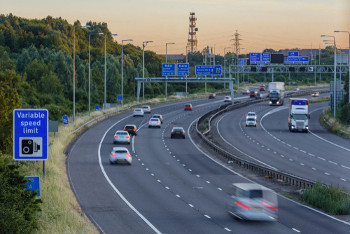The ‘missing piece of the jigsaw’ in the West of Britain is a Great Western Powerhouse waiting to happen, according to a landmark report.
The economic map of Britain is being reshaped by devolution and the emergence of regional powerhouses that can drive inclusive growth at scale through regional collaboration, said the report commissioned by Bristol, Cardiff and Newport City Councils.

Traffic on the M5 near the intersection with the M4
But it highlighted ‘a missing piece of the jigsaw in the West of Britain along the M4 from Swindon across the Welsh Border to Swansea, and the intersecting M5 axis, through Bristol, north to Tewkesbury’.
Its conclusion is ‘that the Great Western cross border area is a powerhouse waiting to happen’.
Launching A Powerhouse to the West, the former head of the civil service and chair of the independent UK2070 commission, Lord Bob Kerslake, said the UK was one of the most geographically unequal countries in the developed world.
He said that ‘despite the best efforts of successive governments that gap has continued to widen’.
‘A Great Western Powerhouse is a serious and credible proposition and conversation has started between the government and the cities at the heart of this. I hope there will be progress over the next six months, making the West of Britain the next powerhouse’, he added.
The report by Metro Dynamics builds on its earlier, exploratory report in 2016 that examined the case for a powerhouse around Bristol, Cardiff and Newport. It has put forward the seven key recommendations for enabling Britain’s next powerhouse to achieve its potential:
- Developing a Great Western Powerhouse Industrial Strategy linking together the sector strengths identified in local industrial strategies in England, and those identified in the Welsh Government strategy ‘Prosperity for All’ – with funding to develop this announced in the Spending Review.
- Tasking the National Infrastructure Commission to work with the region to develop an integrated plan for road and rail improvements to enable fast, more frequent connectivity, both east-west and north-south, with money allocated to this in the Spending Review.
- An Internationalism Strategy for the region to promote trade and investment for its key industrial and economic strengths. The starting point for this should be working with the Department for International Trade (DIT) to develop a joint plan for promoting the region at MIPIM, together with an agreement for dedicated DIT resources to develop the internationalisation plan.
- Better use of data is key to both understanding productivity at a more granular level and spreading innovation, said the report – and it calls for a Productivity and Innovation Observatory to be set up linking the seven Research Councils in Swindon with the Office for National Statistics (ONS) in Newport
- As part of the Great Western Powerhouse Industrial Strategy, to agree to pilot and measure tailored approaches to connecting communities in deprived neighbourhoods with skills and employment opportunities in the region’s high growth sectors.
- Key stakeholders in the regional need to come to a rapid decision about the brand for the cross-border Great Western area.
- The Welsh Government, Department of Business, Energy and Industrial Strategy (BEIS) and UK ministers, together with the city regions, key unitary authorities, local enterprise partnerships (LEPs), business organisations and universities, should agree a joint plan and timescale with which to establish the powerhouse, with a formal announcement make in the Spending Review.
The report says the recent removal of tolls from The Severn Bridge is likely to have a range of economic benefits for the regional and ‘will strengthen economic relationships between England and Wales’.
According to the report, The Great Western Powerhouse already has three city regions – West of England, Cardiff Capital and Swansea Bay City – each of which have identified improved physical and digital connectivity, higher skills and employment levels, and innovation as pivotal to their future economic development and prosperity.
The ‘biggest single missing piece in this jigsaw is the M4/M4 axis in the West of Britain’, the report concluded.
‘This is a highly productive region, but it is not collectively punching its weight and it is losing out as a result’.
This story first appeared on themj.co.uk.
Register now for full access
Register just once to get unrestricted, real-time coverage of the issues and challenges facing UK transport and highways engineers.
Full website content includes the latest news, exclusive commentary from leading industry figures and detailed topical analysis of the highways, transportation, environment and place-shaping sectors.
Use the link below to register your details for full, free access.
Already a registered? Login